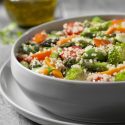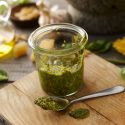Your cravings are all in your imagination – or they should be
Think about your favorite guilty pleasure food. What is it? Potato chips? Cheesecake? Brownies?
Imagine that food in your head. How does it look? What color is it? It is in a wrapper or bag? Did you have to cut a piece and put it on a plate? How does it smell?
Now, imagine taking a bite. What is the first thing you notice? It is warm, cold, or room temperature? Is it salty or sweet? Is it soft or crunchy? Chew the food and imagine how the food responds, and how it feels in your mouth. Notice how the flavor changes as you chew the food. Now swallow the food, and notice the feeling as it travels down your esophagus to your stomach. Imagine taking a few more bites.
Sound like torture? According to research conducted at Carnegie Mellon University, exercises like the one above may actually help to curb cravings, and decrease your consumption of highly desirable foods. This flies in the face of the conventional school of thought that thinking about something desirable increases cravings and consumption.
In the study, the researchers ran five different experiments. In the first experiment, participants were asked to imagine doing a repetitive task 33 times. The control group imagined inserting 33 quarters into a laundry machine. A second group imagined inserting 30 quarters into a laundry machine, and then eating three M&Ms, and a third group imagined inserting three quarters into a laundry machine and then eating 30 M&Ms. All groups then ate freely from a bowl of M&Ms. The group that imagined eating 30 M&Ms ate significantly fewer M&Ms than those that imagined eating none.
The second experiment changed the task imagined, and the number of times the task was repeated, to ensure the results were due to imagining eating the food, rather than the repetitive task. The last three experiments demonstrated that the results are only achieved by imagining eating the food. A decrease in consumption was not observed when the participants simply imagined the food itself, or imagined eating a different food.
These studies showed that the observed reduction in actual eating after imagining eating was due to habituation — a gradual reduction in the motivation to eat more food. This is one of the mechanisms that govern how much we eat, when we stop eating it, and when we switch to another food. The researchers found that the different between experiencing and imagining may be smaller than previously assumed.
This research may have some implications down the road for developing treatments to help with cravings for unhealthy foods, drugs, or cigarettes. But for now, don’t be afraid to think about the foods you may be craving — just make sure you imagine eating the food, too. It just may help you eat less of that food when you do!
I am imagining eating a big slice of New York style cheesecake! What food are you imagining eating today?




